Injury of the distal division of the extremities of cows
DOI:
https://doi.org/10.31210/spi2024.27.01.35Keywords:
сattle, animal welfare, hoof lesion, impaired gait, prevalenceAbstract
Health in cattle is largely determined by the condition of the hoof, since in order to ensure high productivity, the distal section of the cow's limb requires special attention in respect of compliance with anatomical norms and physiological parameters. Hoof need regular care and preventive trimming to prevent disease. Periodic monitoring of their condition not only prevents the development of many pathologies, but also makes it possible to notice dangerous signs – cracks, hemorrhages in the solea ungulae, punctures, purulent pododermatitis, phlegmons of the coronet. The distribution of hoof lesions is established based on historical data, clinical examination, as well as monitoring data obtained during hoof trimming. Hoof trimming is carried out for preventive purposes and to prevent the spread of their diseases, create normal conditions for the growth of the hoof horn and prevent various mechanical damage. It should be borne in mind that hoof damage in cows leads to a sharp decrease in cattle productivity, and in complicated cases can cause premature culling. That is why the existence of prognostic data on the spread of hoof lesions will ensure the ability to prevent the development of hoof lesions in a timely manner. The goal of the work was to identify predictive patterns of formation of pathological processes in cattle in the distal limb on the basis of the analyzed literature and establish their spread depending on productivity, various conditions and containment systems, including climatic influences. Based on the obtained data, a group of criteria can be established in the future, according to which the health status of cow hooves can be monitored, possible formation of pathological processes in them and spread can be predicted. The development of prognostic criteria for this disease will help raise awareness of lameness in dairy cows and will contribute to the totality of understanding of this group of pathologies. The results of the study suggest that the creation of comprehensive computer programs to predict the possible lameness is the first step in planning measures aimed at reducing lameness and hoof lesions.

 Creative Commons Attribution 4.0 International Licens
Creative Commons Attribution 4.0 International Licens